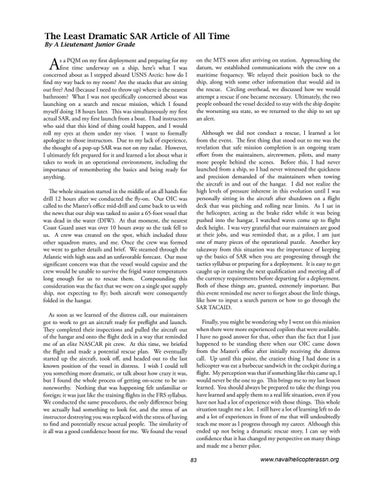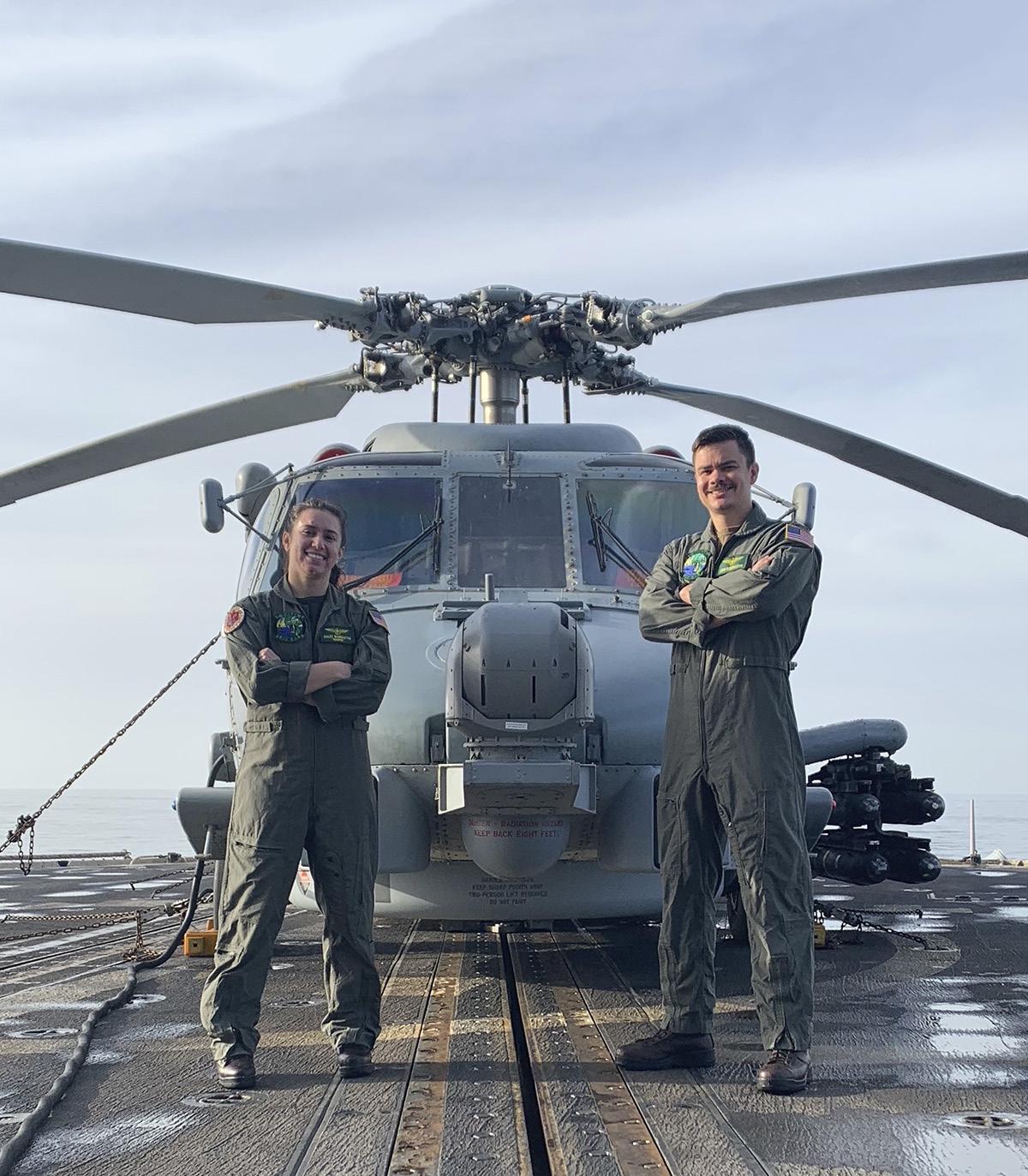The Least Dramatic SAR Article of All Time By A Lieutenant Junior Grade
A
s a PQM on my first deployment and preparing for my first time underway on a ship, here’s what I was concerned about as I stepped aboard USNS Arctic: how do I find my way back to my room? Are the snacks that are sitting out free? And (because I need to throw up) where is the nearest bathroom? What I was not specifically concerned about was launching on a search and rescue mission, which I found myself doing 18 hours later. This was simultaneously my first actual SAR, and my first launch from a boat. I had instructors who said that this kind of thing could happen, and I would roll my eyes at them under my visor. I want to formally apologize to those instructors. Due to my lack of experience, the thought of a pop-up SAR was not on my radar. However, I ultimately felt prepared for it and learned a lot about what it takes to work in an operational environment, including the importance of remembering the basics and being ready for anything. The whole situation started in the middle of an all hands fire drill 12 hours after we conducted the fly-on. Our OIC was called to the Master’s office mid-drill and came back to us with the news that our ship was tasked to assist a 65-foot vessel that was dead in the water (DIW). At that moment, the nearest Coast Guard asset was over 10 hours away so the task fell to us. A crew was created on the spot, which included three other squadron mates, and me. Once the crew was formed we went to gather details and brief. We steamed through the Atlantic with high seas and an unfavorable forecast. Our most significant concern was that the vessel would capsize and the crew would be unable to survive the frigid water temperatures long enough for us to rescue them. Compounding this consideration was the fact that we were on a single spot supply ship, not expecting to fly; both aircraft were consequently folded in the hangar. As soon as we learned of the distress call, our maintainers got to work to get an aircraft ready for preflight and launch. They completed their inspections and pulled the aircraft out of the hangar and onto the flight deck in a way that reminded me of an elite NASCAR pit crew. At this time, we briefed the flight and made a potential rescue plan. We eventually started up the aircraft, took off, and headed out to the last known position of the vessel in distress. I wish I could tell you something more dramatic, or talk about how crazy it was, but I found the whole process of getting on-scene to be unnoteworthy. Nothing that was happening felt unfamiliar or foreign; it was just like the training flights in the FRS syllabus. We conducted the same procedures, the only difference being we actually had something to look for, and the stress of an instructor destroying you was replaced with the stress of having to find and potentially rescue actual people. The similarity of it all was a good confidence boost for me. We found the vessel
on the MTS soon after arriving on station. Approaching the datum, we established communications with the crew on a maritime frequency. We relayed their position back to the ship, along with some other information that would aid in the rescue. Circling overhead, we discussed how we would attempt a rescue if one became necessary. Ultimately, the two people onboard the vessel decided to stay with the ship despite the worsening sea state, so we returned to the ship to set up an alert. Although we did not conduct a rescue, I learned a lot from the event. The first thing that stood out to me was the revelation that safe mission completion is an ongoing team effort from the maintainers, aircrewmen, pilots, and many more people behind the scenes. Before this, I had never launched from a ship, so I had never witnessed the quickness and precision demanded of the maintainers when towing the aircraft in and out of the hangar. I did not realize the high levels of pressure inherent in this evolution until I was personally sitting in the aircraft after shutdown on a flight deck that was pitching and rolling near limits. As I sat in the helicopter, acting as the brake rider while it was being pushed into the hangar, I watched waves come up to flight deck height. I was very grateful that our maintainers are good at their jobs, and was reminded that, as a pilot, I am just one of many pieces of the operational puzzle. Another key takeaway from this situation was the importance of keeping up the basics of SAR when you are progressing through the tactics syllabus or preparing for a deployment. It is easy to get caught up in earning the next qualification and meeting all of the currency requirements before departing for a deployment. Both of these things are, granted, extremely important. But this event reminded me never to forget about the little things, like how to input a search pattern or how to go through the SAR TACAID. Finally, you might be wondering why I went on this mission when there were more experienced copilots that were available. I have no good answer for that, other than the fact that I just happened to be standing there when our OIC came down from the Master’s office after initially receiving the distress call. Up until this point, the craziest thing I had done in a helicopter was eat a barbecue sandwich in the cockpit during a flight. My perception was that if something like this came up, I would never be the one to go. This brings me to my last lesson learned. You should always be prepared to take the things you have learned and apply them to a real life situation, even if you have not had a lot of experience with those things. This whole situation taught me a lot. I still have a lot of learning left to do and a lot of experiences in front of me that will undoubtedly teach me more as I progress through my career. Although this ended up not being a dramatic rescue story, I can say with confidence that it has changed my perspective on many things and made me a better pilot. 83
www.navalhelicopterassn.org









































